(click on photos to enlarge images)
TIFFANY DATE LETTERS AND MARKS
There are many variations in the maker's marks used by Tiffany &
Co., the below is only intended to give a basic guideline to the
holloware markings.
A goodly number of the mark variations are illustrated in Charles H.
Carpenter's fine book, 'Tiffany Silver'.
In the early years, a number of different silversmiths supplied Tiffany
with silver holloware & flatware and marked the pieces with their own
marks as well as the Tiffany marks.
The examples above only show John Moore's mark, some of the others were:
William Gale, John Polhemus, Grosjean & Woodward, Wood & Hughes, Henry
Hebbard, and William Bogert.
After the Moore silversmithing firm was absorbed into Tiffany & Co.
(about 1870) and Tiffany began the production of its own silverware, it
became the tradition to mark each piece with the initial of the Artistic
Director or President of the firm. This practice continued until the mid
1960's.
Tiffany maker's marks
|
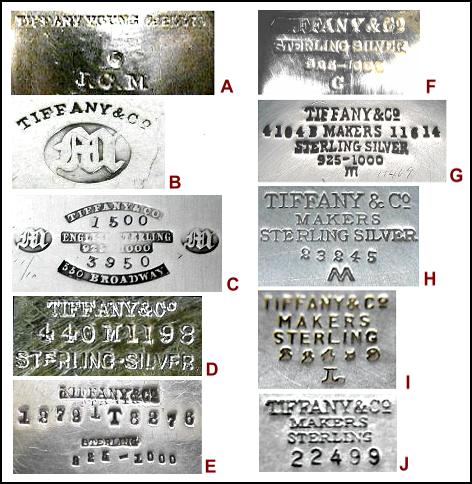
|
|
A - c.1848 ~ 1852 Tiffany, Young & Ellis (J.C. Moore, maker)
B - 1853 (J.C. Moore, maker)
C - c.1854 ~ 1870 (J.C. Moore &; Son, maker)
D - 1873 ~ 1891 (directorship of Edward Moore)
E - 1892 ~ 1902 (directorship of Charles L. Tiffany)
F - 1902 ~ 1907 (directorship of Charles T. Cook)
G - 1907 ~ 1947 (directorship of John C. Moore II)
H - 1947 ~ 1956 (directorship of Louis deBebian Moore)
I - 1956 ~ c.1965 (directorship of William T. Lusk)
J - c. 1965 ~ Present
|
Tiffany Holloware Pattern Numbers
Tiffany & Co's use of Pattern numbers allows us to date when a design
was first put into production, as many popular designs were produced for
many years, they only provide a guideline.
Using them in conjunction with the director's initial mark does often
give a fairly accurate circa date.
Order numbers are, for all intents and purposes, not useful to us. They
were used 'in house' to keep track of production.
Without access to the Tiffany archives, they have no real meaning.
|

|
|
Tiffany Holloware Pattern Numbers
|
1851 ~ 1
1856 ~ 301
1860 ~ 1,001
1865 ~ 1,551
1870 ~ 2,251
1875 ~ 3,801
1876 ~ 4,545
1877 ~ 4,620
1878 ~ 5,050
1879 ~ 5,370
1880 ~ 5,910
1881 ~ 6,260
1882 ~ 6,760
1883 ~ 7,300
1884 ~ 7,840
1885 ~ 8,340
1886 ~ 8,800
1887 ~ 9,260
1888 ~ 9,660
1889 ~ 10,120
|
1890 ~
10,400
1891 ~ 10,820
1892 ~ 11,140
1893 ~ 11,520
1894 ~ 11,940
1895 ~ 12,220
1896 ~ 12,600
1897 ~ 13,040
1898 ~ 13,510
1899 ~ 13,900
1900 ~ 14,250
1901 ~ 14,650
1902 ~ 15,145
1903 ~ 15,550
1904 ~ 15,943
1905 ~ 16,356
1906 ~ 16,555
1907 ~ 16,849
1908 ~ 17,103
1909 ~ 17,272
|
1910 ~
17,596
1911 ~ 17,880
1912 ~ 18,190
1913 ~ 18,395
1914 ~ 18,601
1915 ~ 18,808
1916 ~ 18,996
1917 ~ 19,193
1918 ~ 19,460
1919 ~ 19,521
1920 ~ 19,683
1921 ~ 19,831
1922 ~ 20,021
1923 ~ 20,160
1924 ~ 20,296
1925 ~ 20,470
1926 ~ 20,664
1927 ~ 20,845
1928 ~ 21,177
1929 ~ 21,352
|
1930 ~ 21,470
1931 ~ 21,724
1932 ~ 21,855
1933 ~ 21,950
1934 ~ 21,987
1935 ~ 22,100
1936 ~ 22,280
1937 ~ 22,360
1938 ~ 22,575
1939 ~ 22,650
1940 ~ 22,850
1941 ~ 22,950
1942 ~ 23,140
1944 ~ 23,164
1945 ~ 23,177
1946 ~ 23,204
1947 ~ 23,238
1948 ~ 23,250
1949 ~ 23,274
1950 ~ 23,310
|
Tiffany & Company ~ A Brief History
The Tiffany dynasty was founded in 1837 at 259 Broadway in New York City by
Charles Louis Tiffany and partner John B. Young.
It began not as a jewelry & silver emporium, but as a purveyor of
stationery and fancy goods under the name Tiffany & Young. Although
America was in a deep economic recession, the store soon acquired a respected
name and flourished with its quality merchandise imported from Europe,
India and the Orient.
In 1841, a new partner, J. L. Ellis joined the firm and the name changed to
Tiffany, Young & Ellis. The first of the Tiffany 'Blue Book' catalogs
appeared in 1845 and with it the first indications of silver merchandise
carried; a small range of personal items and all, almost certainly, imported.
The firm expanded to larger quarters at 271 Broadway in 1847, the move
enabled a significant increase in the retailing of silver and jewelry.
It is here that American made silver finally took its place alongside the
Tiffany name.
The goods were made mostly by New York City silversmiths and often bore their
maker's marks, as well as the Tiffany retailer's mark.
1851 was an important year in the history of American silver, Tiffany,
Young & Ellis, seeking to give their silver goods distinction, became
the first American firm to introduce the use of the English Sterling (.925)
standard in American made silver.
Deciding that they wanted more control, they contracted with the firm of
John C. Moore, one the finest American holloware silversmithies, to produce
exclusively for Tiffany's.
Both Young & Ellis retired in 1853, giving Charles Tiffany control of
the firm, again he moved it to larger quarters at 550 Broadway and the name
was changed to that which we know today, Tiffany & Company.
Over the next two decades, Tiffany worked closely with J. C. Moore and,
increasingly with his son, Edward Chandler Moore, who had fully taken the
reins of Moore concern in the 1860's. Together, the artist Moore and the businessman Tiffany, created many landmark pieces of American silver and spread the fame of Tiffany & Company silverware. In 1867, at the Exposition Universelle in Paris, Tiffany's became the first American firm to win an award for excellence in silver.
Charles L. Tiffany made a landmark decision in 1868, he reached an agreement
with Edward C. Moore and purchased the Moore firm. At this juncture, Tiffany & Company became a silver manufacturer as well as a silver retailer. For his part, Edward Moore became a Tiffany stockholder and the general manager of the silverware end of the business. His first important step was to expand production to include flatware manufacturing. In 1869 "Tiffany", the company's first flatware pattern, premiered and the firm moved to new and larger quarters on Union Square.
Moore was a cultured man, an avid world traveler and collector of art and
objects of the Near & Far East. As the Aesthetic Movement style became
fashionable, his innovative nature and knowledge of Eastern art combined
with his superlative design skills to bring Tiffany's to the forefront of
American silver manufacturers.
Many of the finest Japanesque and Moorish Revival objects ever created,
including major presentation pieces, were made by Tiffany & Company at
this time.
By the time of Edward Moore's death in 1891, Tiffany & Co. had won major
awards at successive European and American Expositions and had become the
most internationally respected American silver manufacturer. The founder,
Charles L. Tiffany passed on in 1902, leaving a legacy based on sound
business judgement and goods of exceptional quality.
Tiffany & Company moved to its present quarters at 5th Avenue & 57th
Street in 1940 and remained in the hands of the Tiffany & Moore families
until 1955.
this article is based on a page available in
www.925-1000.com
website
upon kind permission of Tom Guarrera - ASCAS member
a selection of Tiffany silver
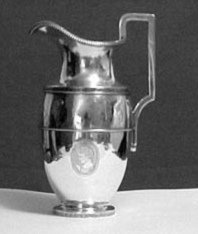 |
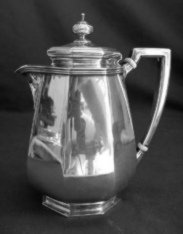 |
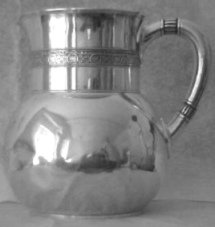 |
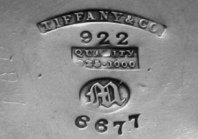 |
 |
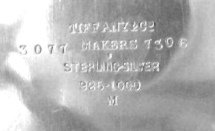 |
pitcher
922
 6677
6677
|
coffee pot
10166
 2266
2266
|
pitcher
3077 M 7306
|
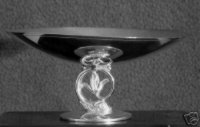 |
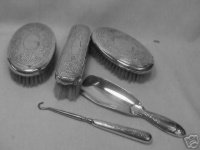 |
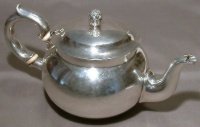 |
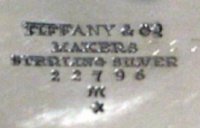 |
 |
 |
tazza
22796

|
dresser/vanity set
15088G
 14562 14562
|
teapot
6393 M 7700
|
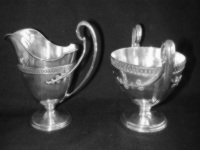 |
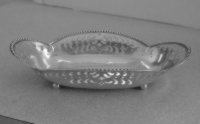 |
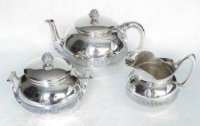 |
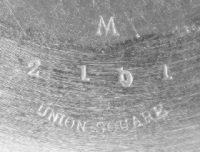 |
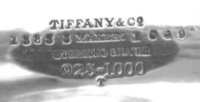 |
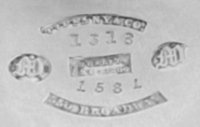 |
cream and sugar
2551 M
|
basket
1383 3 T 1049
|
tea set
1318
 1581
1581
|
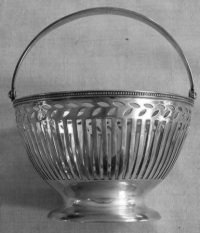 |
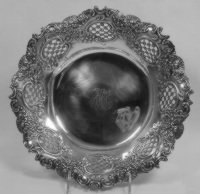 |
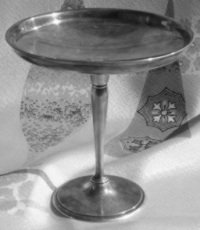 |
 |
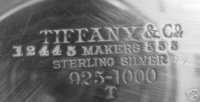 |
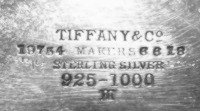 |
basket
16942
|
bowl
12445 T 555
|
compote
19754
 6618
6618
|
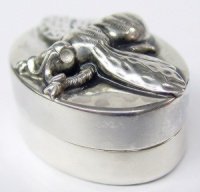 |
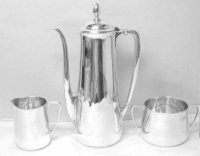 |
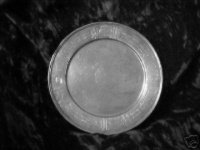 |
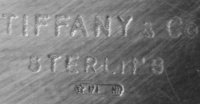 |
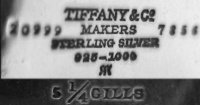 |
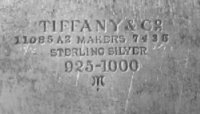 |
pill box
* 174 MI
maker: Argenteria Galbiati srl
Milano Italy
|
coffee set
20999
 7856
7856
|
plate
11085
 7435 7435
|
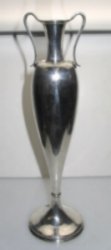 |
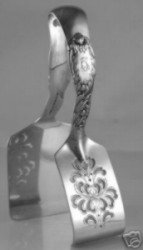 |
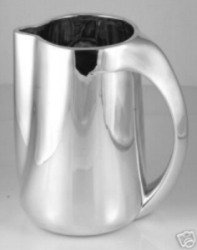 |
 |
 |
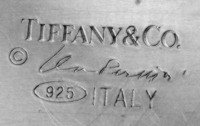 |
urn vase
11251 T 4374
|
asparagus tongs
1622
|
pitcher
by Elsa Peretti - Italy
|
|
|